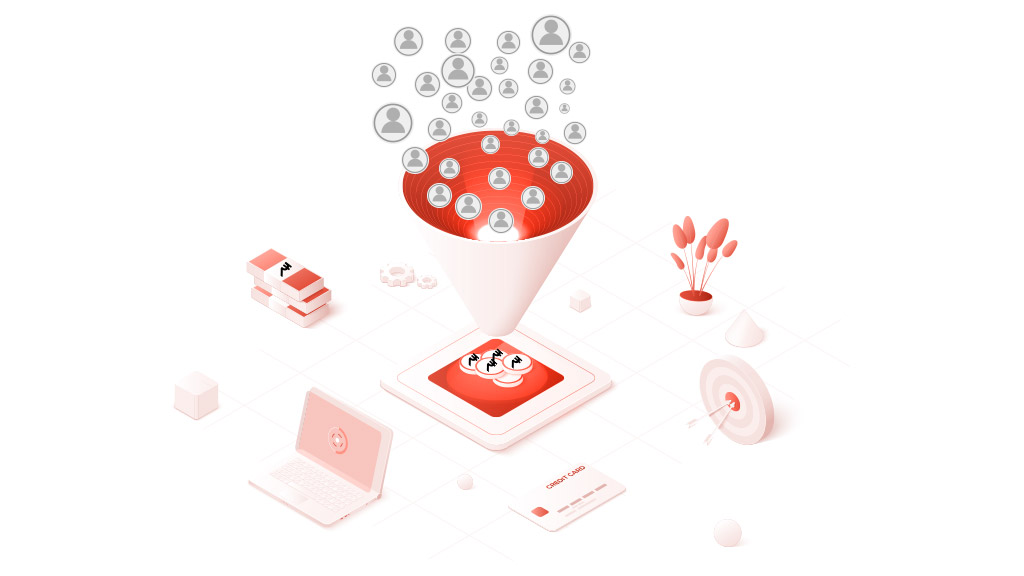The pandemic has made obsolete the world we knew. There’s no going back to the old normal. We have to adapt to the “new normal.”
Though these words may be hard to accept, the reality is that the Covid-19 outbreak has changed everything forever. Gone are the days when B2B companies had a fleet of sales personnel, who visited potential customers in person and helped in closing the sale.
With local lockdowns in different parts of the country and inter-state travel restrictions still in place, business travel has come to an abrupt standstill. Though it looks like we have crossed the worst of the second wave, it will be a long-long time before we get back to any form of normalcy.
At this crucial juncture, it’s critical for B2B businesses to transition to online selling. You would have heard the proverb, “every crisis presents an opportunity.” It’s time that B2B companies go online and create an online selling eco-system that is focused and efficient.
Data by HubSpot reveals that website traffic in 2020 has doubled and tripled compared to 2019 pre-Covid-19 traffic levels. Just like B2C buyers, B2B buyers have also transitioned to online purchases. And, the pandemic has accelerated this transition.
The big question now is: Has the increase in online website traffic translating to sales?
 Well, that depends on whom you ask. B2B companies with a sales-oriented website and a well-planned marketing strategy have actually seen an increase in sales during the Covid-19 crisis. 1 in 2 companies that sell online reported an increase in sales volumes during the pandemic.
Well, that depends on whom you ask. B2B companies with a sales-oriented website and a well-planned marketing strategy have actually seen an increase in sales during the Covid-19 crisis. 1 in 2 companies that sell online reported an increase in sales volumes during the pandemic.
But, what about the rest? B2B businesses that don’t have an online presence struggled to make ends meet during the pandemic. A vast majority of them even had to shut shop or downsize.
What’s the key takeaway from these stats?
 B2B businesses can no longer afford to ignore their online presence. Just like B2C, B2B businesses require a robust business website that is sales-oriented and customer-focused. In this post, Webfries, the no.1 website design company in Gurgaon, shares tips and strategies on how to grow your B2B business during the pandemic with the right website.
B2B businesses can no longer afford to ignore their online presence. Just like B2C, B2B businesses require a robust business website that is sales-oriented and customer-focused. In this post, Webfries, the no.1 website design company in Gurgaon, shares tips and strategies on how to grow your B2B business during the pandemic with the right website.
Your website is the Best Salesperson for your B2B Business – But, is it Sales-Oriented?
 The primary focus of a B2B business is not selling the product online but generating leads. Then, what do we mean by making your website design sales-ready? Let us explain.
The primary focus of a B2B business is not selling the product online but generating leads. Then, what do we mean by making your website design sales-ready? Let us explain.
Unlike B2C purchases, B2B purchases are not impulse buys. It can take a customer anywhere from a few months to two years to make a buying decision. A sales-ready website provides your customers’ key support during the entire buying cycle.
In other words, it acts as the go-to point for all customer queries. It helps in winning the trust of potential buyers and gets them to convert.
Questions to Ask while Designing or Updating your B2B Website
Is the Site Customer-Focussed?
 The biggest mistake B2B companies make is that their website is not customer-centric. Instead, they focus more on their business – talking about their history, their events, their news, and their products. While all this information is essential, you have to keep in mind that a customer who lands on your site from Google is not likely to be interested in it.
The biggest mistake B2B companies make is that their website is not customer-centric. Instead, they focus more on their business – talking about their history, their events, their news, and their products. While all this information is essential, you have to keep in mind that a customer who lands on your site from Google is not likely to be interested in it.
Remember, if your website doesn’t serve customers, it doesn’t help your business either;
A customer-centric business puts the customer at the center. It makes it easy for the customer to do business with your company. Here are a few tips to make your B2B website customer-focussed:
Address the pain points of the customer – Rather than heaping praises on your products/services, focus on how your product helps to address the customer’s needs and problems. Explain the specific benefits of your product that will help customers address their needs.
Establish your Authority in the Industry – Think beyond selling. Offer educational and informative blog posts, case studies, videos, and other content that helps to build trust in your brand. Your website must inspire confidence in the customer to do business with you.
Make it easy for the customers to locate information – Your website must make it easy for the customer to achieve a specific goal. For example, if your goal is to generate leads, then your site must display contact information prominently so that customers can easily contact you. On the other hand, if your goal is to get customers to complete an online order, then make the online purchase process simple and straightforward.
Keep your site user-friendly and mobile-friendly – Today, the vast majority of customers browse online sites from their mobiles and other handheld devices. Having a responsive, mobile-first design is critical to keep customers on your page. A non-mobile design means that first-time visitors are unlikely to return.
Is the Site Sales-Focused?
 If you think of your website as an online visiting card, then you’re leaving money on the table. To get the best returns from your B2B website, you need to think of it as a sales tool.
If you think of your website as an online visiting card, then you’re leaving money on the table. To get the best returns from your B2B website, you need to think of it as a sales tool.
Your website is your best salesperson.
A recent study reveals that 94% of the buyer’s journey today happens online. Customers have more or less made a decision before they even contact your business. So, it’s critical that your website does the role of an online sales rep for you.
The website has to provide all the relevant information offered by your sales team. The site has to provide the relevant content for all these queries:
What are you selling? As soon as a customer lands on your site, he/she should be able to see clearly what are the products and services you are offering. Use the right content and images to make what you’re selling clear to your audience.
What’s the USP of your products/services? This is the key value proposition you’re offering to customers. Explain the key benefits of your products clearly to customers and get them excited to do business with your company.
What sets you apart? What makes your product/service different from your competitors? What are the benefits that customers get when they purchase your product?
Why should customers purchase from you? Very often, first-time customers want to be 100% sure that they are making the right decision by purchasing from you. You can inspire customer confidence by displaying authentic reviews, case studies, customer testimonials, etc.
Also, train your sales team to leverage your website to close the deal. For example, a salesperson can guide potential customers to the review section of your website to inspire customer trust and confidence.
You will get more tips by clicking here


 Social media today is mandatory for all businesses regardless of size and industry. Social media makes it easy to build a stronger bond with your audience. Instead, of using your social media channels just to promote your products/services, use them to genuinely help your audience.
Social media today is mandatory for all businesses regardless of size and industry. Social media makes it easy to build a stronger bond with your audience. Instead, of using your social media channels just to promote your products/services, use them to genuinely help your audience. Social media is not just promoting your products/services. Instead, you need to use the channel to help your audience.
Social media is not just promoting your products/services. Instead, you need to use the channel to help your audience. Whatsapp and FB Messenger are great tools for local businesses.
Whatsapp and FB Messenger are great tools for local businesses. Google My Business page is the starting point to build digital visibility online for your business. It helps to direct customers to your website when they search for specific keywords like, “
Google My Business page is the starting point to build digital visibility online for your business. It helps to direct customers to your website when they search for specific keywords like, “ Do you search for online reviews before you complete a purchase? The same applies to your customers. So, you need to focus on getting authentic reviews from happy customers. It’s a great selling point and helps you convert your target audience into paying customers.
Do you search for online reviews before you complete a purchase? The same applies to your customers. So, you need to focus on getting authentic reviews from happy customers. It’s a great selling point and helps you convert your target audience into paying customers. Here’s an example: let’s state that your state has announced a lockdown. If you share a discount code promoting customers to walk into your store, then it creates a disconnect with the audience as they know there is a lockdown going on.
Here’s an example: let’s state that your state has announced a lockdown. If you share a discount code promoting customers to walk into your store, then it creates a disconnect with the audience as they know there is a lockdown going on.
 As a local business, being a part of local programs improves the credibility of your business. Sponsor a cause close to your heart and showcase it on your digital media channels.
As a local business, being a part of local programs improves the credibility of your business. Sponsor a cause close to your heart and showcase it on your digital media channels. Loyalty programs are a great way to keep customers shopping with you again and again. Giving a 10% discount on second purchases or a gift at the end of ten purchases are a great way to keep customers interested in your business.
Loyalty programs are a great way to keep customers shopping with you again and again. Giving a 10% discount on second purchases or a gift at the end of ten purchases are a great way to keep customers interested in your business. Digital marketing is a rapidly changing field. Strategies that work today will become irrelevant six months down the line. If you’re handling digital marketing on your own, it’s a good idea to update yourself with a digital marketing course. Alternatively, you can handle the job to professionals, like Webfries, the
Digital marketing is a rapidly changing field. Strategies that work today will become irrelevant six months down the line. If you’re handling digital marketing on your own, it’s a good idea to update yourself with a digital marketing course. Alternatively, you can handle the job to professionals, like Webfries, the 




















